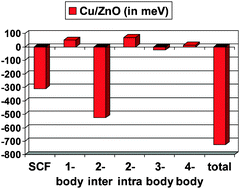The method of local increments is used in connection with the supermolecule approach and an embedded cluster model to calculate the adsorption energy of single Cu atoms at different adsorption sites at the polar surfaces of ZnO. Hartree–Fock calculations for the full system, adsorbed atom and solid surface, and for the fragments are the first step in this approach. In the present study, restricted open-shell Hartree–Fock (ROHF) calculations are performed since the Cu atom possesses a singly-occupied 4s orbital. The occupied Hartree–Fock orbitals are then localized by means of the Foster–Boys localization procedure. The correlation energies are expanded into a series of many-body increments which are evaluated separately and independently. In this way, the very time-consuming treatment of large systems is replaced with a series of much faster calculations for small subunits. In the present application, these subunits consist of the orbitals localized at the different atoms. Three adsorption situations with rather different bonding characteristics have been studied: a Cu atom atop a threefold-coordinated O atom of an embedded Zn4O4cluster, a Cu atom in an O vacancy site at the O-terminated ZnO(000–1) surface, and a Cu atom in a Zn vacancy site at the Zn-terminated ZnO(0001) surface. The following properties are analyzed in detail: convergence of the many-body expansion, contributions of the different n-body increments to the adsorption energy, treatment of the singly-occupied orbital as “localized” or “delocalized”. Big savings in computer time can be achieved by this approach, particularly if only the localized orbitals in the individual increment under consideration are described by a large correlation adapted basis set, while all other orbitals are treated by a medium-size Hartree–Fock-type basis set. In this way, the method of local increments is a powerful alternative to the widely used methods like DFT or RI-MP2.

You have access to this article
 Please wait while we load your content...
Something went wrong. Try again?
Please wait while we load your content...
Something went wrong. Try again?


 Please wait while we load your content...
Please wait while we load your content...